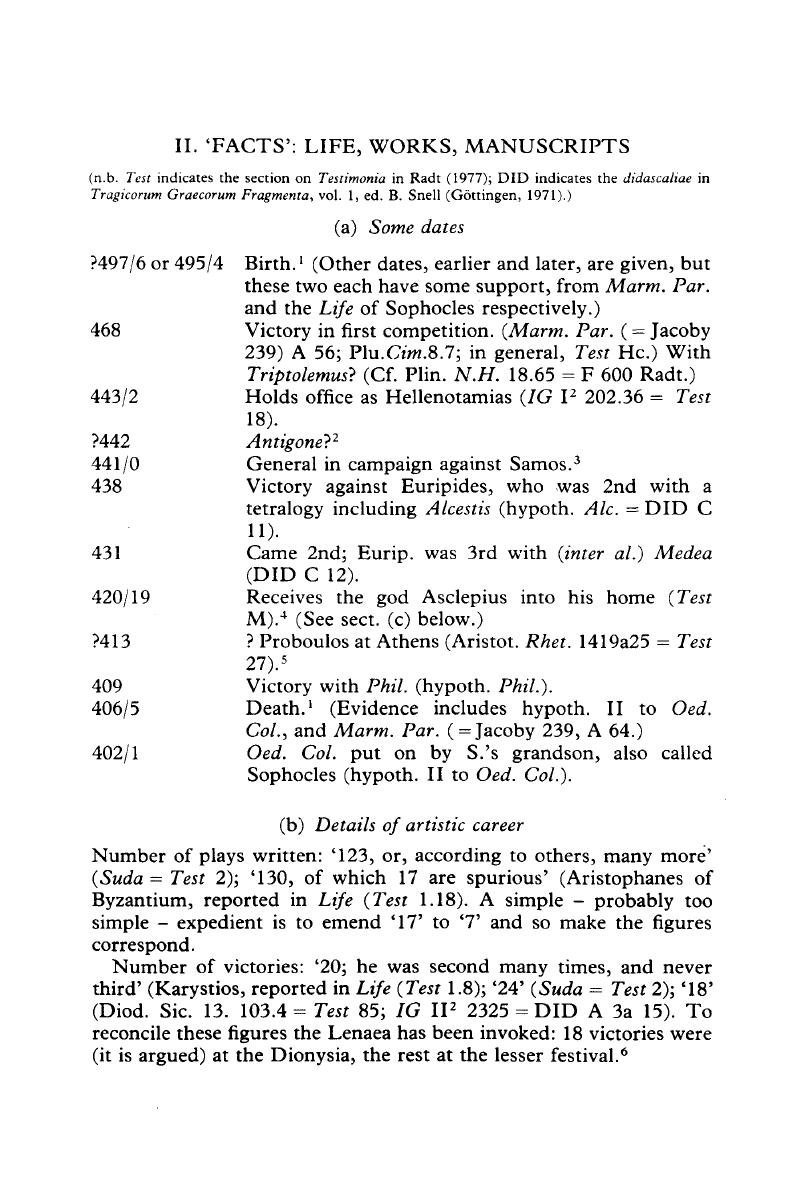No CrossRef data available.
Published online by Cambridge University Press: 05 February 2016

1. For dates of birth and death see F. Jacoby FGrHist, on 244 (Apollodoros) F 35; also Test B.
2. From hypothesis I to Ant. (cf. Test 25) we learn that Sophocles’ success with the play won him the generalship in the Samian campaign. Is this credible? Woodbury, L., ‘Sophocles among the Generals’, Phoenix 24 (1970), 209-24CrossRefGoogle Scholar, thinks it is; Reinhardt, K., Sophocles (Eng. tr. Oxford, 1979), p. 240 Google Scholar, was dubious. Not incompatible with a date of 442 for Ant. is the information that Ant. came 32nd in S.’s output (hypoth. I and II to Ant. = Test 159a-b). As Flickinger showed (CPh 5 (1910), 1-18; The Greek Theater and its Drama4 (Chicago, 1936), pp. 330-7) this number will work if it comes from a chronological list of S.’s plays compiled at a time when some of them had been lost. (See also Pearson (1917), vol. 1, xviff.).
3. From a statement ascribed to Androtion (Jacoby 324 F 38 = Test 19) we learn that one of Sophocles’ colleagues was Pericles. For the reason why we put S.’s generalship in 441/0 not 440/39 see Jacoby ad loc.
4. For date see Körte, A., MDAI(A) 18(1893), 246-9Google Scholar.
5. See Jameson, M. H., ‘Sophocles and the Four Hundred’, Historia 20 (1971), 541-68Google Scholar.
6. Cf.Russo, C. F., ‘Euripide e i concorsi tragici lenaici’, MH 17 (1960), 165-70Google Scholar, at 165-6.
7. For a bracingly sceptical approach see Mary, Lefkowitz, The Lives of the Greek Poets (London, 1981)Google Scholar. (See also the review of Lefkowitz by J. Fairweather (CR 32 (1982), 183-4), whose own article ‘Fiction in the biographies of ancient writers’, AncSoc 5 (1974), 231-75, is highly relevant.) A more traditional account of Sophocles’ life is given by Lesky, A., Die tragische Dichtung der Hellenen3 (Göttingen, 1972), pp. 169-75Google Scholar.
8. Less sceptical about the historicity of the quarrel are e.g. Hense, O., Studien zu Sophokles (Leipzig, 1880), pp. 289–310 Google Scholar, and Mazon, P., ‘Sophocle devant ses juges’, REA 47 (1945), 82–96 CrossRefGoogle Scholar.
9. For this mysterious figure see Pauly-Wissowa RE III.A.1. 1044-5.
10. Weinreich, O., Antike Heilungswunder (Giessen, 1909), pp. 38 Google Scholarff., sees the ‘healing right hand’ as the primary significance of ‘Dexion’, any connection with the ‘welcoming’ of Asclepius being secondary.
11. Ferguson, W. S., ‘The Attic orgeones’, HThR 37 (1944), 61–140 Google Scholar, at 90.
12. von Wilamowitz-Moellendorff, U., Der Glaube der Hellenen (Berlin, 1931-2), vol. 2, pp. 232-3Google Scholar (‘dieser fromme Mann ...’); Dodds, E. R., The Greeks and the Irrational (Berkeley, 1951), p. 193 Google Scholar.
13. E. J., and Edelstein, L., Asclepius (Baltimore, 1945), vol. 2, p. 117 n. 24 Google Scholar; followed by Lloyd-Jones, H., The Justice of Zeus (Berkeley, 1971), pp. 192-3 n. 13 Google Scholar.
14. If we insist on connecting the Asclepius story with the plays it had better be done in the cautious terms advocated by Kirkwood, G. M., A Study of Sophoclean Drama (Cornell, 1958), pp. 25-6Google Scholar.
15. There is a breathtaking example in Seidensticker, B., ‘Die Stichomythie’, in Jens, W., Die Bauformen der griechischen Tragödie (Munich, 1971), p. 209 Google Scholar, who says in relation to Ajax: ‘When he wrote the earliest of his surviving plays Sophocles was about 45 years old, with about twenty years’ experience of the stage.’ For arguments about the date of Ajax see App. G. to Stanford (1963), and Lesky (1972), pp. 180-1 n. 2.
16. P. Oxy. 2256 fr. 3, exhaustively discussed in Garvie, A. F., Aeschylus’ ‘Supplices’: Play and Trilogy (Cambridge, 1969)Google Scholar.
17. Edn of Ajax, lii.
18. Reinhardt (1979); the original came out in 1933 (3rd edn in 1947).
19. Cf. the review by Rivier, A. (MH 21 (1964), 243)Google Scholar of Schwinge, E.-R., Die Stellung der Trachinierinnen im Werk des Sophokles (Göttingen, 1962)CrossRefGoogle Scholar. Schwinge is explicitly in Reinhardts debt in his attempt to date Trach.
20. Knox (1979), pp. 112ff. For different arguments and another date (411) see Diano, C. in Dioniso 15 (1952), 81ffGoogle Scholar.
21. On attempts to locate Ajax in relation to history see Johansen (1962), 171 and Winnington-Ingram (1980), p. 72 n. 38. On Elec. see Lloyd-Jones, H. in CR 19 (1969), 36-8Google Scholar; on Trach. see Easterling (1982), pp. 19-23.
22. For a helpful account see App. 2 of Easterling (1982).
23. De falsa leg. 246.
24. (Plu.) Vit. dec. or. 841f.
25. Alexandria: Pfeiffer, R., History of Classical Scholarship, vol. 1 (Oxford, 1968), pp. 87ffGoogle Scholar. Byzantium: Reynolds, L. D. and Wilson, N. G., Scribes and Scholars (Oxford, 1968), ch. 2 Google Scholar; and Wilson, N. G., Scholars of Byzantium (London, 1983)Google Scholar.
26. On manuscripts which preserve scholia see the praefatio to de Marco, V., Scholia in Sophoclis Oedipum Coloneum (Rome, 1952)Google Scholar, reviewed by Erbse, H. in Gnomon 27 (1955), 84-7Google Scholar; and see also Dawe, R. D., Studies on the Text of Sophocles (Leiden, 1973-8), vol. 1, pp. 113-19Google Scholar. An edn of the scholia was done by P. N. Papageorgios (Leipzig, 1888) for the Teubner series.
27. Turyn, A., Studies in the Manuscript Tradition of the Tragedies of Sophocles (Illinois, 1952)Google Scholar; cf.Easterling, P. E., ‘The manuscript A of Sophocles and its relation to the Moschopulean recension’, CQ 10 (1960), 51–64 CrossRefGoogle Scholar.
28. Dawe (1982), p. 26.
29. Cf. his preface to Ajax (Leiden, 1953). K.’s subsequent reaction to Turyn - K. believes the Parisinus is not valueless - is at Mnemosyne 11 (1958), 25-31.